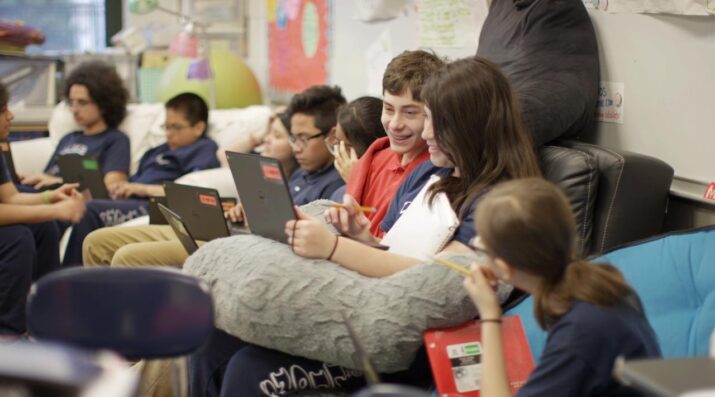New Designs for School
Get More Traction for Your Awesome Universal Design for Learning Program, Part II
Topics

We’ve all had the experience of truly purposeful, authentic learning and know how valuable it is. Educators are taking the best of what we know about learning, student support, effective instruction, and interpersonal skill-building to completely reimagine schools so that students experience that kind of purposeful learning all day, every day.
This second post in Tobin's series explains why UDL isn't equivalent to providing accommodations, and it isn't only a focus for faculty members.
In my first post, we explored the origins of UDL and some misconceptions at both an individual and a system-wide level about equating UDL with providing accommodations.
Let’s begin by reframing UDL away from disability and situate it in a neutral narrative we’re all familiar with: mobile learning.
Oh, Wait, I was Looking at My Phone
In comparison with learners just 15 years ago, today’s college students are:
- more likely to require remediation,
- more likely to have poor study and time-management skills and
- less likely to have significant time for study outside of the classroom.
Many college students are adult learners with families and jobs—and little time for studying: “Adult learners are juggling family, work, and educational responsibilities. They don’t do optional.”
A recent EDUCAUSE study shows that 86% of college students own smartphones. Couple this with busy lifestyles, and mobile-friendly design fosters any-time, anywhere learning:
“As an integral part of students’ daily lives, mobile technology has changed how they communicate, gather information, allocate time and attention, and potentially how they learn. . . . Learners are no longer limited to the classroom’s geographical boundaries; for example, they can now record raw observations and analyze data on location. Furthermore, mobile technology platforms let individuals discuss issues with their colleagues or classmates in the field. The ever-growing mobile landscape thus represents new opportunities for learners both inside and outside the classroom.”
The argument for adopting UDL has always been based on its benefits for all learners, but for years we haven’t had a simple case that demonstrates those benefits. Now we have one: UDL reaches out to learners on mobile devices and gives them more time for studying.
UDL Isn’t Just a Faculty Job
Next, let’s move the focus away from training faculty members about UDL. Let’s also train the people who support them: IT departments, teaching and learning centers, media services areas, academic department staff, and the help desk.
There is near consensus that institutions are responsible to provide education to the broadest audience of learners (Rapp & Arndt, 2012). Too often, though, we leave inclusion to the office of disability services or individual faculty members. UDL training courses increase faculty confidence in working with students across the ability spectrum (Murray et al, 2011), but the higher-education UDL adoption rate hovers around 10% of faculty members (cf. Murray et al., 2009).
Why? Faculty members don’t do what they used to.
Over the past three decades, the role of faculty members has become increasingly atomized. For example, faculty members in 1985 were expected to:
- design their course structure,
- create individual syllabi,
- pull together ancillary materials (e.g., “prof packs,” transparencies, and vendor-produced VHS tapes),
- teach course sessions,
- grade student work, and
- hold office hours.
Today, faculty members are still responsible for content expertise. However, much of what used to be an individual faculty member’s job is now the responsibility of the entire faculty (e.g., agreeing on common syllabi, reading lists, and texts) or of support staff (e.g., creating videos, multimedia, and LMS content).
Often, course content and interactions are designed by a team:
- the faculty member,
- an instructional designer,
- a media specialist,
- an IT coder, and
- other staff throughout the institution.
UDL training should focus on the people who actually put together the interactions for courses. Implementing UDL principles across an institution requires leadership support and resources. As Candyce Rennegarbe at Tacoma Community College reports, the investment is worth it:
“By far, strong administrative support is the most important element. Our Vice President of Academic and Student Affairs has supported this project with funding and personal support since we started. He has used Achieving the Dream [program] funds and reserve funds; no major grant funding has been accessed to fund this project. We give release time to a faculty member to be the project manager in an affordable way to make sure there is sustained leadership. . . . We have also secured stipends for faculty and mentors and have involved the instructional research department from the beginning. We have a strong cross-disciplinary advisory team (Dean/VP of Instruction, Access Services, E-Learning, Developmental Studies, Professional Development, Student Services, Faculty), and strong support for building technology resources on campus.” (in Meyer, et al., 2014).
This approach—training those who actually do the development work on materials and interactions that UDL touches on—results in greater levels of adoption of UDL across the institution (Meyer et al., 2014).
The College STAR (Supporting Transition, Access, and Retention) consortium is a UDL success story. Colleges and universities across North Carolina used a federal grant in order to create a curriculum shared across campuses. All participating campuses sent their support and design staff to UDL training sessions; now all courses are “born with UDL.”
This is the goal of UDL, after all: to reduce barriers to learning for everyone. While we should keep learners with disabilities always in mind, we serve the broadest audience by situating UDL as a way to reach mobile learners through any-time, anywhere interactions, and we should train our support staff in UDL, so faculty members who want to innovate are automatically presented with UDL as “just the way we do things here.”
This is the second post in a two-part series on Universal Design for Learning. Read the first post.




